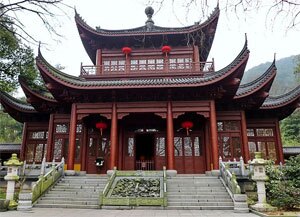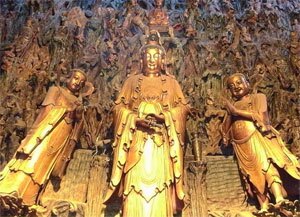Lingyin Temple is a top site in the West Lake area of Hangzhou, part of the Wulin Mountains, and noted as one of the most important and famous Buddhist temples in the country of China. This magnificent structure is found tucked in a long, narrow valley between Fei Lai Feng (Peak Flown from Afar) and North Peak, both to the northwest of West Lake. In 1961, protection was declared for Lingyin Temple due to its status as a key provincial historical and cultural site for the nature. It is also a continuing pillar and center for research relative to Chinese Buddhist culture. Its translated name even rings pure, meaning Temple of the Soul's Retreat.
 The history of Lingyin Temple goes back to the Eastern Jin Dynasty (317-420). According to records and legends, an Indian monk by the name of Huili arrived here and the nature so captivated his heart and spiritual body. Therefore he stayed here and established the Temple of the Soul's Retreat. Indeed, visitors arrive here daily and are able to feel true tranquility and reflection in this natural site.
The history of Lingyin Temple goes back to the Eastern Jin Dynasty (317-420). According to records and legends, an Indian monk by the name of Huili arrived here and the nature so captivated his heart and spiritual body. Therefore he stayed here and established the Temple of the Soul's Retreat. Indeed, visitors arrive here daily and are able to feel true tranquility and reflection in this natural site.
During the ages of the Five Dynasties (907-960), the king of the Wu Yue State commenced another building era for the temple, resulting in its expansion, as a sign of his fidelity to Buddha. At this time, Lingyin Temple had 9 buildings, 18 pavilions, 77 palaces and halls, and a total of more than 13,000 rooms to house about 3,000 Buddhist monks. The immense scale of this temple is not found commonly and its survival through the centuries of war, social change, and political instability only continues to make it stronger.
The main temple seen today on a visit is the result of renovations that took place in 1974. Visitors will find a tablet in the first hall, also known as the Hall of the Heavenly Kings and the main entrance to the temple area. The tablet has inscriptions from the mouth of Emperor Kangxi of the Qing Dynasty. He fell so in love with the temple and its surroundings that he called it “Cloud Forest Buddhist Temple.” The hall with its elegant and impressive double eaves and many more details also includes an image of what is known as the Four Heavenly Kings on either side of an immense statue of a laughing Buddha with a jolly belly. He brims with joy at all those who enter. The hall is also fantastically painted with sophisticated phoenixes and dragons of all kinds.
 The Hall of the Great Hero is across the courtyard. It is a single story construction also boasting double eaves on the roof. Although it is just 1 story, it stands at 33.6 meters tall, making it one of the tallest of its kind in China. Visitors will find a statue of Sakyamuni, also known as Buddha himself. The work is made of 24 sections of camphor wood and stands as tall as about 15 humans. It is one of the most immense wooden statues in the country, not to mention it is also coated in gold leaf. Twenty saints said to be the protectors of justice surround Sakyamuni.
The Hall of the Great Hero is across the courtyard. It is a single story construction also boasting double eaves on the roof. Although it is just 1 story, it stands at 33.6 meters tall, making it one of the tallest of its kind in China. Visitors will find a statue of Sakyamuni, also known as Buddha himself. The work is made of 24 sections of camphor wood and stands as tall as about 15 humans. It is one of the most immense wooden statues in the country, not to mention it is also coated in gold leaf. Twenty saints said to be the protectors of justice surround Sakyamuni.
Other distinctive parts of the temple to experience are the Grand Hall of the Great Sage, Hall of the Medicine Buddha, Sutra Library built in the years 2000-2002, Huayan Hall, and the Hall of the Five Hundred Arhats with an interesting floor layout shaped like a Buddhist swastika lined with indeed 500 arhats.
In modern times today, Lingyin Temple continues to be a place of refuge for worshippers as well as a site for tourism. The environment of the Wuling Mountains add additional allure to the destination and the entire scenic area now includes various historic constructions, artwork, pagodas, pavilions, bridges, and statues of the religious persuasion. Nearby are the Feilai Feng grottoes, also known as Flying Peak, where to be found are a number of Buddhist carvings and statues created directly into the rocks.